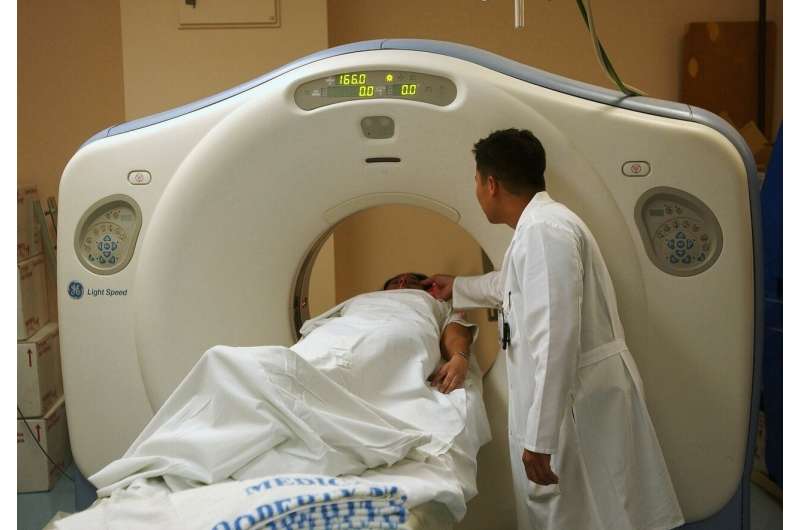This article has been reviewed according to Science X's editorial process and policies. Editors have highlighted the following attributes while ensuring the content's credibility:
fact-checked
trusted source
proofread
New study validates prediction rules for pediatric intra-abdominal and traumatic brain injuries

Delivering high-quality emergency care for kids may mean fewer CT scans, according to a new study from UC Davis Health's Department of Emergency Medicine.
The research, published in The Lancet Child & Adolescent Health Journal, validates intra-abdominal injury (IAI) and traumatic brain injury (TBI) prediction rules established by the Pediatric Emergency Care Applied Research Network (PECARN).
The IAI and TBI prediction rules were created by co-principal investigators Nathan Kuppermann, chair of Emergency Medicine, and James Holmes, executive vice chair of Emergency Medicine. They sought to decrease inappropriate computed tomography (CT) use in injured children.
According to the Centers for Disease Control and Prevention (CDC), trauma is the leading cause of death in children in the United States. Among pediatric traumatic deaths, TBI has been the most common cause and IAI accounts for 30% of cases.
Currently, CT scanning is the standard for diagnosing IAIs and TBIs. However, the procedure is associated with lethal ionizing radiation-inducing malignancies, or cancer, at an estimated rate of one per 500 abdominal CT scans in children younger than five years of age. In adolescents, the figure is one per 600 scans.
"A CT scan can be a useful diagnostic tool for diagnosing and treating patients, but it also has risks of radiation-induced malignancy," explained Kuppermann. "By validating these evidence-based rules, we hope to decrease unnecessary CT imaging of children with head or abdominal trauma and increase patient safety by decreasing the risks of potential malignancies."
Benefits of IAI and TBI rules
The study was conducted at six pediatric trauma centers. However, prior evidence suggests the PECARN IAI and TBI rules can be safely implemented in community hospitals. By utilizing the IAI and TBI rules, community hospitals can increase the readiness of their emergency departments to care for acutely sick and injured children.
"The care a child receives in the emergency department can set them on a path to survival or not," explained Holmes. "These rules can increase readiness of emergency departments to ensure that every child receives high-quality emergency care."
Additionally, authors of the study believe these results could impact racial and ethnic differences in medical imaging use in emergency departments throughout the United States.
"Evidence shows there are racial, ethnic and demographic disparities in medical imaging use in emergency departments," said Kuppermann. "Providing clinicians an evidence-based protocol to follow can standardize and prevent any differences in care."
Methods and findings of the study
The investigators conducted a prospective cohort study in six Level-1 pediatric trauma centers. They studied the cases of children younger than 18 years with blunt abdominal or minor head trauma. Enrolled children were evaluated if they were positive or negative for the previously derived PECARN prediction rules prior to knowledge of CT results.
Overall, 7,542 patients with blunt abdominal trauma and 19,999 patients with head trauma were enrolled in the study. The IAI rule had an accuracy rate of 100% (145/145) for patients needing a CT scan and a negative predictive value of 100% (3,488/3,488).
The TBI rule for patients younger than 2 years had an accuracy rate of 100% (42/42) for patients needing a CT scan and a negative predictive value of 100% (2,940/2,940). For children 2 years and older, the TBI rule had an accuracy rate of 98.8% (168/170) for patients needing a CT scan and a negative predictive value of 99.97% (6,015/6,017). Neither of the two children with TBIs misclassified by the TBI rule required neurosurgery or other therapy beyond hospital observation.
"With this robust validation, these clinical prediction rules should now be widely disseminated and implemented into clinical practice," said Holmes. "Widespread use may further decrease unnecessary CT scans in injured children."
More information: James F Holmes et al, PECARN prediction rules for CT imaging of children presenting to the emergency department with blunt abdominal or minor head trauma: a multicentre prospective validation study, The Lancet Child & Adolescent Health (2024). DOI: 10.1016/S2352-4642(24)00029-4

















